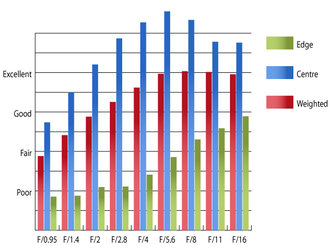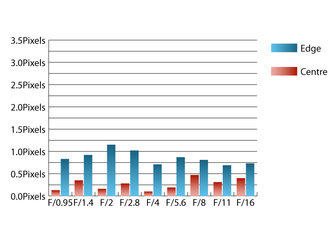SLR Magic 50mm f/0.95 Hyperprime Lens Review
SLR Magic 50mm f/0.95 Hyperprime Lens Performance
SLR Magic talk much about the 'dreamy' quality of this lens on their website, which doesn't build much in the way of expectation regarding the sharpness it will deliver. However, despite there being noticeable hazing at fast apertures due to spherical aberrations, this lens delivers fairly good sharpness at f/0.95 in the centre of the frame, which could make this lens ideal for portraiture. Stopping down improves sharpness in the centre to outstanding levels from around f/2.8 and beyond, although the sharpness towards the edges of the frame never really catches up.  Resolution at 50mm | How to read our chartsThe blue column represents readings from the centre of the picture frame at the various apertures and the green is from the edges. Averaging them out gives the red weighted column.The scale on the left side is an indication of actual image resolution. The taller the column, the better the lens performance. Simple. For this review, the lens was tested on a Panasonic Lumix G3 using Imatest. |
Chromatic aberrations are slightly high towards the edges of the frame at all apertures, exceeding one pixel width at f/2. As a result, care may need to be taken when placing areas of high contrast near the edges of the frame.
 Chromatic aberration at 50mm | How to read our chartsChromatic aberration is the lens' inability to focus on the sensor or film all colours of visible light at the same point. Severe chromatic aberration gives a noticeable fringing or a halo effect around sharp edges within the picture. It can be cured in software.Apochromatic lenses have special lens elements aspheric, extra-low dispersion etc. to minimize the problem, hence they usually cost more. For this review, the lens was tested on a Panasonic Lumix G3 using Imatest. |
Falloff of illumination towards the corners is very well controlled for a lens with such a fast maximum aperture. At maximum aperture, the corners are 1.04 stops darker than the image centre and illumination is visually uniform by f/2.8.
Imatest detected 0.497% barrel distortion, which is fairly typical for a telephoto with a fast maximum aperture. The distortion pattern is uniform across the frame, so applying corrections in image editing software should be relatively straightforward.
Images taken with this lens have a certain look to them that can only be described as 'vintage' due to the low contrast delivered by the lens, especially when shooting into the light. This look may not be everyone's cup of tea, but it should certainly be appreciated by portrait photographers. The aperture has eight blades, which are curved in the opposite direction to what you may normally expect. This can result in busy looking out of focus highlights as the aperture is not circular, being more like an eight pointed star.
Add your message
Login required
Please login here or if you've not registered, you can register here. Registering is safe, quick and free.
Please login here or if you've not registered, you can register here. Registering is safe, quick and free.
photodo Stats
1102 lenses
428 MTF tests
74 in-depth photodo reviews
100+ users join each day
Help the lens community by reviewing or rating a lens today via our lens search
428 MTF tests
74 in-depth photodo reviews
100+ users join each day
Help the lens community by reviewing or rating a lens today via our lens search
Latest Lens Reviews
- Chinon 28mm f/2.8 Vintage Lens Review
- Canon EF 70-200mm f/4L IS II USM Lens Review
- Samyang AF 85mm f/1.4 EF Review
- Sigma 70mm f/2.8 DG Macro Art Review
- Samyang AF 24mm f/2.8 FE Review
- Meike 50mm f/1.7 Review
- Tamron 70-210mm f/4 Di VC USD Review
- Lensbaby Burnside 35mm f/2.8 Review
- Asahi Super Takumar 50mm f/1.4 Review
- Asahi Super-Multi-Coated Takumar 135mm f/3.5 Review
